Decision Making, Problem Solving, and Business Analysis Homework
VerifiedAdded on 2023/01/06
|10
|2329
|61
Homework Assignment
AI Summary
This document provides a detailed solution to a decision-making and problem-solving assignment. It begins by exploring the hierarchy of information-based business decision-makers, emphasizing the importance of the top tier driven by market analysis and research. The assignment then addresses a business problem of increasing expenses for XYZ Limited, outlining a step-by-step business research approach including problem identification, research design, method selection, sampling, data collection, and report preparation. It further explains asymmetrical relationships, detailing stimulus-response, property-disposition, and disposition-behavior connections. Different interview formats like telephone, video, panel, group, face-to-face, and informational interviews are discussed. The solution also covers the concepts of validity, reliability, and practicality in measurement, along with content, construct, and criterion validity. Finally, it presents data analysis components including a graph and explanations of the central limit theorem, confidence intervals, confidence levels, interval estimates, and point estimates.
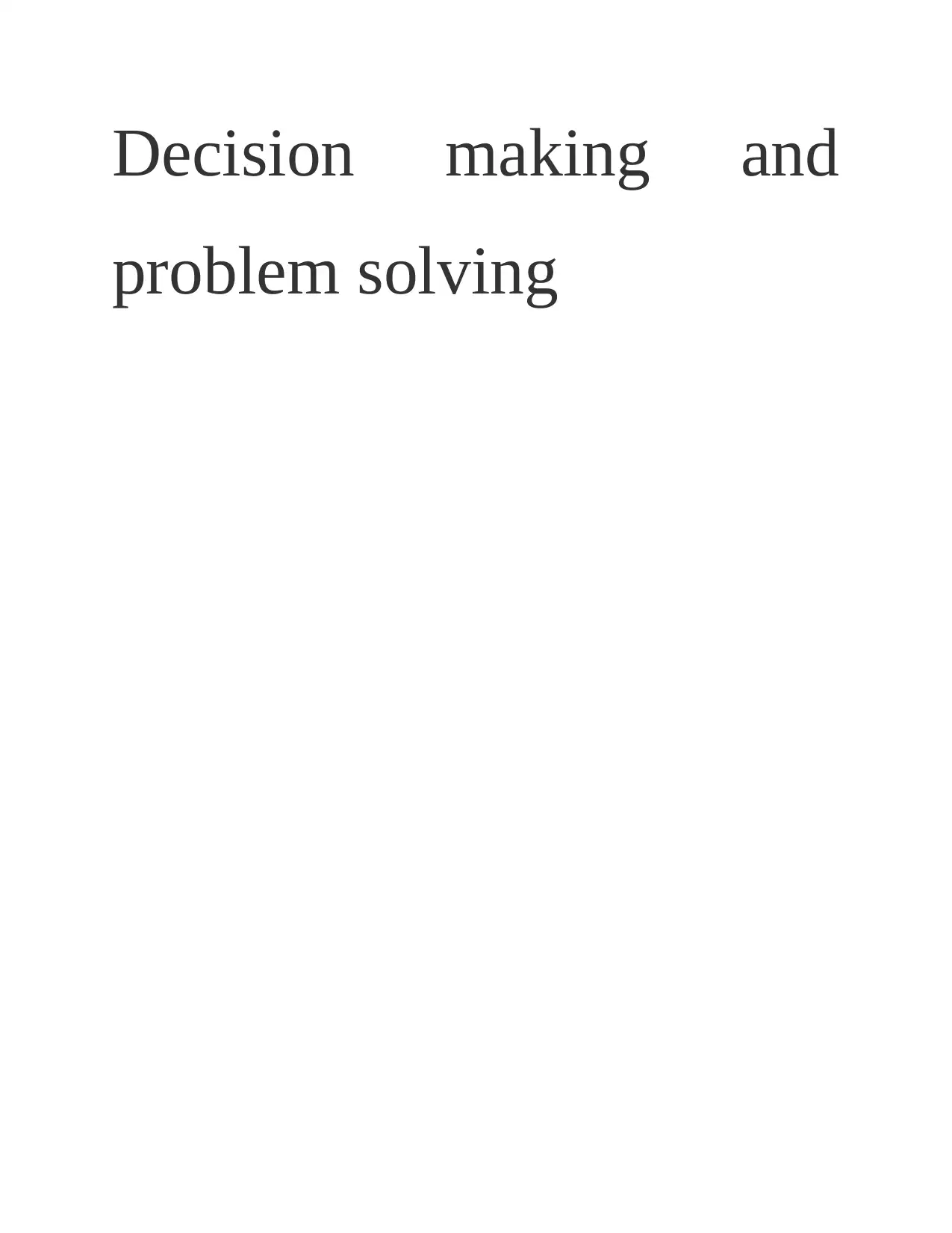
Decision making and
problem solving
problem solving
Paraphrase This Document
Need a fresh take? Get an instant paraphrase of this document with our AI Paraphraser

Contents
MAIN BODY..............................................................................................................................................3
Question 1...............................................................................................................................................3
Question 2...............................................................................................................................................4
Question 3...............................................................................................................................................5
Question 4...............................................................................................................................................6
Question 5...............................................................................................................................................7
Question 6...............................................................................................................................................8
References...................................................................................................................................................9
MAIN BODY..............................................................................................................................................3
Question 1...............................................................................................................................................3
Question 2...............................................................................................................................................4
Question 3...............................................................................................................................................5
Question 4...............................................................................................................................................6
Question 5...............................................................................................................................................7
Question 6...............................................................................................................................................8
References...................................................................................................................................................9
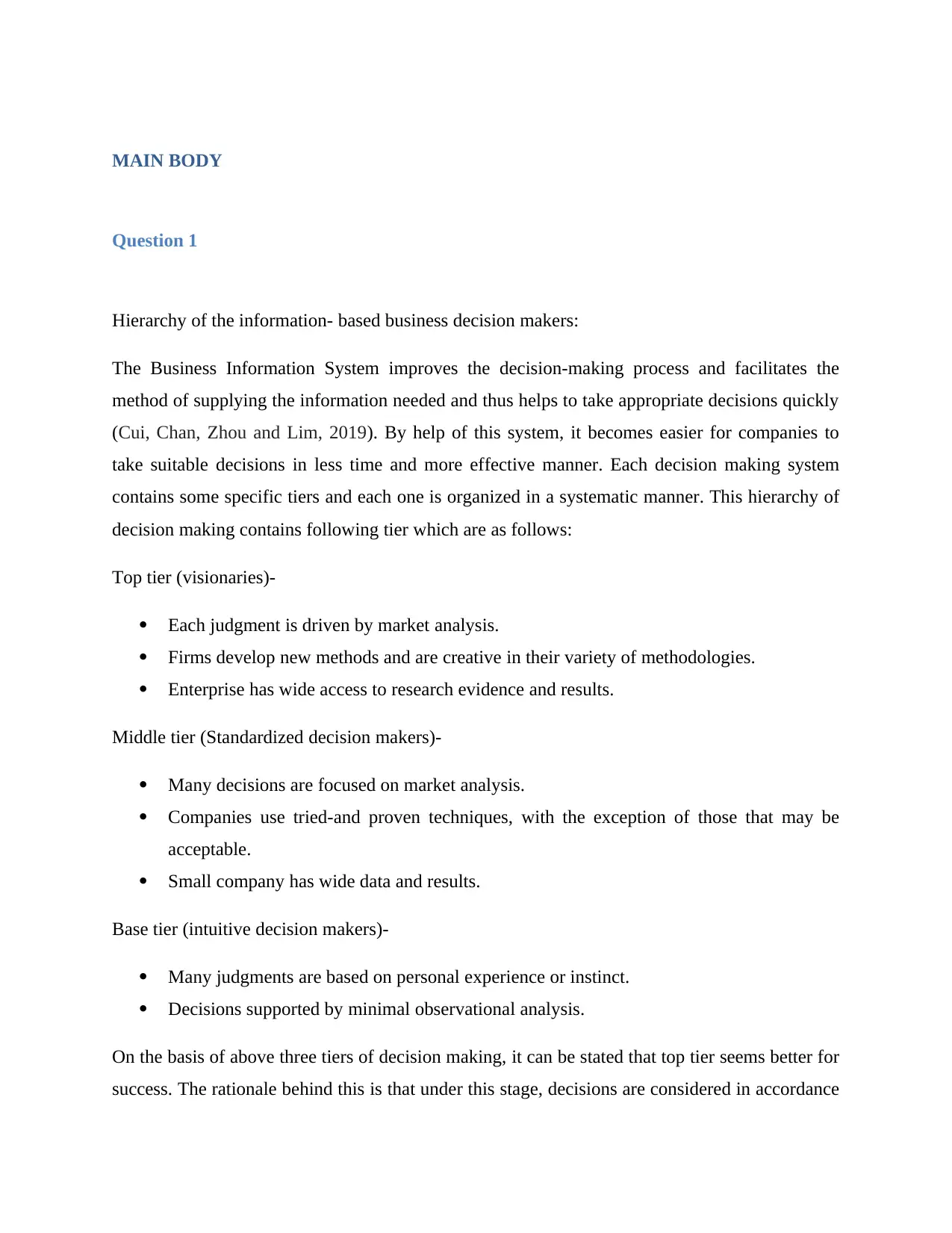
MAIN BODY
Question 1
Hierarchy of the information- based business decision makers:
The Business Information System improves the decision-making process and facilitates the
method of supplying the information needed and thus helps to take appropriate decisions quickly
(Cui, Chan, Zhou and Lim, 2019). By help of this system, it becomes easier for companies to
take suitable decisions in less time and more effective manner. Each decision making system
contains some specific tiers and each one is organized in a systematic manner. This hierarchy of
decision making contains following tier which are as follows:
Top tier (visionaries)-
Each judgment is driven by market analysis.
Firms develop new methods and are creative in their variety of methodologies.
Enterprise has wide access to research evidence and results.
Middle tier (Standardized decision makers)-
Many decisions are focused on market analysis.
Companies use tried-and proven techniques, with the exception of those that may be
acceptable.
Small company has wide data and results.
Base tier (intuitive decision makers)-
Many judgments are based on personal experience or instinct.
Decisions supported by minimal observational analysis.
On the basis of above three tiers of decision making, it can be stated that top tier seems better for
success. The rationale behind this is that under this stage, decisions are considered in accordance
Question 1
Hierarchy of the information- based business decision makers:
The Business Information System improves the decision-making process and facilitates the
method of supplying the information needed and thus helps to take appropriate decisions quickly
(Cui, Chan, Zhou and Lim, 2019). By help of this system, it becomes easier for companies to
take suitable decisions in less time and more effective manner. Each decision making system
contains some specific tiers and each one is organized in a systematic manner. This hierarchy of
decision making contains following tier which are as follows:
Top tier (visionaries)-
Each judgment is driven by market analysis.
Firms develop new methods and are creative in their variety of methodologies.
Enterprise has wide access to research evidence and results.
Middle tier (Standardized decision makers)-
Many decisions are focused on market analysis.
Companies use tried-and proven techniques, with the exception of those that may be
acceptable.
Small company has wide data and results.
Base tier (intuitive decision makers)-
Many judgments are based on personal experience or instinct.
Decisions supported by minimal observational analysis.
On the basis of above three tiers of decision making, it can be stated that top tier seems better for
success. The rationale behind this is that under this stage, decisions are considered in accordance
⊘ This is a preview!⊘
Do you want full access?
Subscribe today to unlock all pages.

Trusted by 1+ million students worldwide
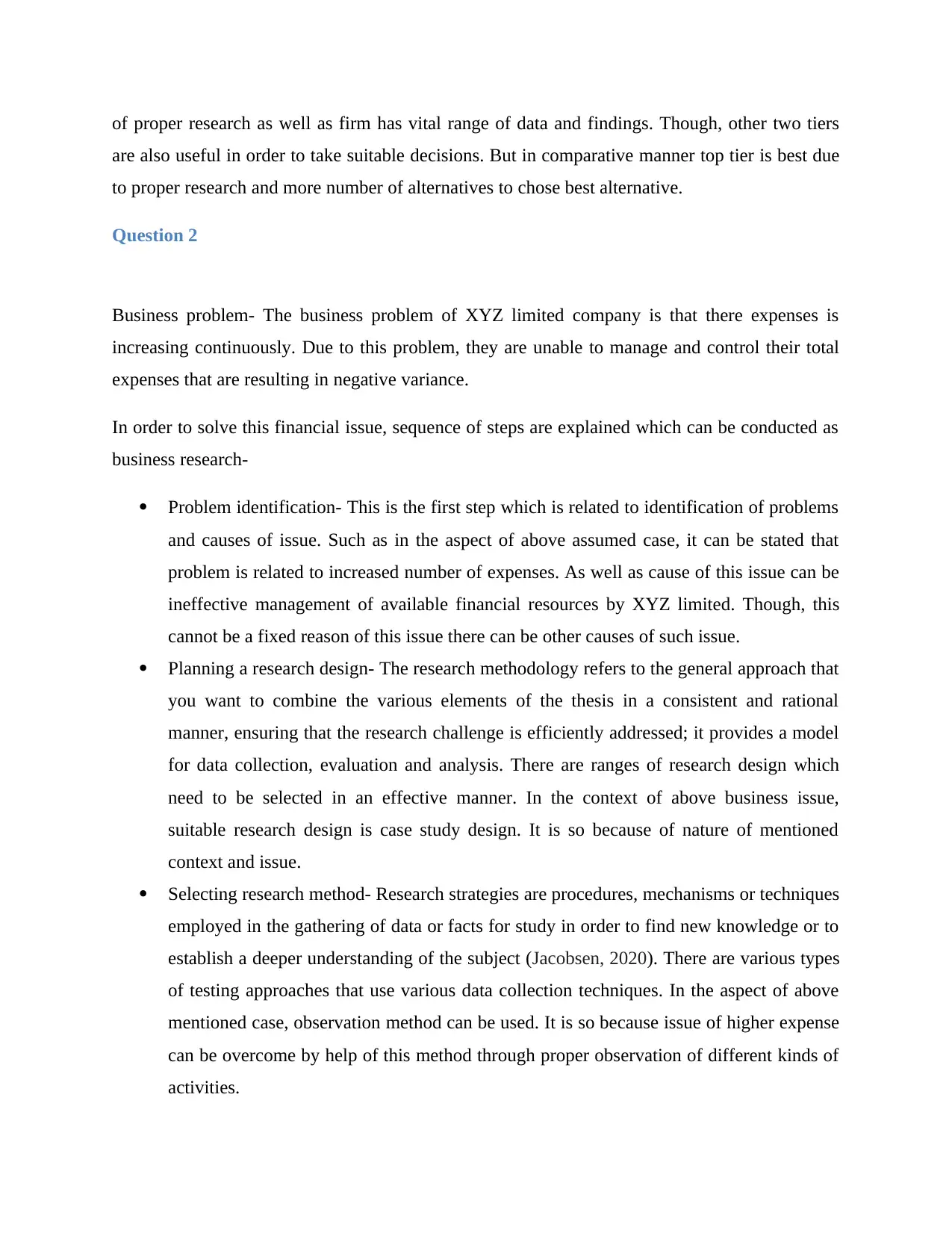
of proper research as well as firm has vital range of data and findings. Though, other two tiers
are also useful in order to take suitable decisions. But in comparative manner top tier is best due
to proper research and more number of alternatives to chose best alternative.
Question 2
Business problem- The business problem of XYZ limited company is that there expenses is
increasing continuously. Due to this problem, they are unable to manage and control their total
expenses that are resulting in negative variance.
In order to solve this financial issue, sequence of steps are explained which can be conducted as
business research-
Problem identification- This is the first step which is related to identification of problems
and causes of issue. Such as in the aspect of above assumed case, it can be stated that
problem is related to increased number of expenses. As well as cause of this issue can be
ineffective management of available financial resources by XYZ limited. Though, this
cannot be a fixed reason of this issue there can be other causes of such issue.
Planning a research design- The research methodology refers to the general approach that
you want to combine the various elements of the thesis in a consistent and rational
manner, ensuring that the research challenge is efficiently addressed; it provides a model
for data collection, evaluation and analysis. There are ranges of research design which
need to be selected in an effective manner. In the context of above business issue,
suitable research design is case study design. It is so because of nature of mentioned
context and issue.
Selecting research method- Research strategies are procedures, mechanisms or techniques
employed in the gathering of data or facts for study in order to find new knowledge or to
establish a deeper understanding of the subject (Jacobsen, 2020). There are various types
of testing approaches that use various data collection techniques. In the aspect of above
mentioned case, observation method can be used. It is so because issue of higher expense
can be overcome by help of this method through proper observation of different kinds of
activities.
are also useful in order to take suitable decisions. But in comparative manner top tier is best due
to proper research and more number of alternatives to chose best alternative.
Question 2
Business problem- The business problem of XYZ limited company is that there expenses is
increasing continuously. Due to this problem, they are unable to manage and control their total
expenses that are resulting in negative variance.
In order to solve this financial issue, sequence of steps are explained which can be conducted as
business research-
Problem identification- This is the first step which is related to identification of problems
and causes of issue. Such as in the aspect of above assumed case, it can be stated that
problem is related to increased number of expenses. As well as cause of this issue can be
ineffective management of available financial resources by XYZ limited. Though, this
cannot be a fixed reason of this issue there can be other causes of such issue.
Planning a research design- The research methodology refers to the general approach that
you want to combine the various elements of the thesis in a consistent and rational
manner, ensuring that the research challenge is efficiently addressed; it provides a model
for data collection, evaluation and analysis. There are ranges of research design which
need to be selected in an effective manner. In the context of above business issue,
suitable research design is case study design. It is so because of nature of mentioned
context and issue.
Selecting research method- Research strategies are procedures, mechanisms or techniques
employed in the gathering of data or facts for study in order to find new knowledge or to
establish a deeper understanding of the subject (Jacobsen, 2020). There are various types
of testing approaches that use various data collection techniques. In the aspect of above
mentioned case, observation method can be used. It is so because issue of higher expense
can be overcome by help of this method through proper observation of different kinds of
activities.
Paraphrase This Document
Need a fresh take? Get an instant paraphrase of this document with our AI Paraphraser

Selecting sampling procedure- Sampling is the method or procedure of identifying a sub-
group from a population to participation in the research; it is the process of identifying an
amount of persons for the research in such a manner that the subjects reflect the large
number from that they were picked. In the aspect of above mentioned case and issue,
systematic sampling can be applied so that all activities can be managed in a proper ways.
Data collection- Data collection is the method of collecting and evaluating information
about target parameters in the developed framework, which then allows one to answer the
relevant queries and analyze the results. In related to above mentioned case, data can
be collected from various kinds of budgets and actual outcome of expenses. By help of
this, it becomes easier for above XYZ limited to overcome from issue.
Preparation of research report- It is the last stage which is related to preparation of
research report that contains detailed information about how data is collected and which
kinds of strategy has been applied to solve the issue.
Question 3
Asymmetrical relationship refers to changes in one factor (independent variable) that induces the
improvement in another fluctuating (independent variable). There are 3 major types of
asymmetric connections.
Stimulus response relationship- The simplest form of response is a straightforward one-
to-one stimulus-response approach. The stimuli are a change that occurs; the sensitivity
of the individual to it is a result. In single-celled species, the answer is the product of
cells properties. Stimulus response interaction shows the presence of an incident as a
response to such changes. Successful revamping campaigns, for example, can have
positive consequences for overall sales.
Property-disposition relationship- Property disposition connection is the association
between a person’s personality or condition and the accompanying behavior or tendency
(Sheikh and Mukhtar, 2020). In this situation, the average time can be stretched over a
prolonged period of time. Property is synonymous with the lasting essence of the issue,
group from a population to participation in the research; it is the process of identifying an
amount of persons for the research in such a manner that the subjects reflect the large
number from that they were picked. In the aspect of above mentioned case and issue,
systematic sampling can be applied so that all activities can be managed in a proper ways.
Data collection- Data collection is the method of collecting and evaluating information
about target parameters in the developed framework, which then allows one to answer the
relevant queries and analyze the results. In related to above mentioned case, data can
be collected from various kinds of budgets and actual outcome of expenses. By help of
this, it becomes easier for above XYZ limited to overcome from issue.
Preparation of research report- It is the last stage which is related to preparation of
research report that contains detailed information about how data is collected and which
kinds of strategy has been applied to solve the issue.
Question 3
Asymmetrical relationship refers to changes in one factor (independent variable) that induces the
improvement in another fluctuating (independent variable). There are 3 major types of
asymmetric connections.
Stimulus response relationship- The simplest form of response is a straightforward one-
to-one stimulus-response approach. The stimuli are a change that occurs; the sensitivity
of the individual to it is a result. In single-celled species, the answer is the product of
cells properties. Stimulus response interaction shows the presence of an incident as a
response to such changes. Successful revamping campaigns, for example, can have
positive consequences for overall sales.
Property-disposition relationship- Property disposition connection is the association
between a person’s personality or condition and the accompanying behavior or tendency
(Sheikh and Mukhtar, 2020). In this situation, the average time can be stretched over a
prolonged period of time. Property is synonymous with the lasting essence of the issue,
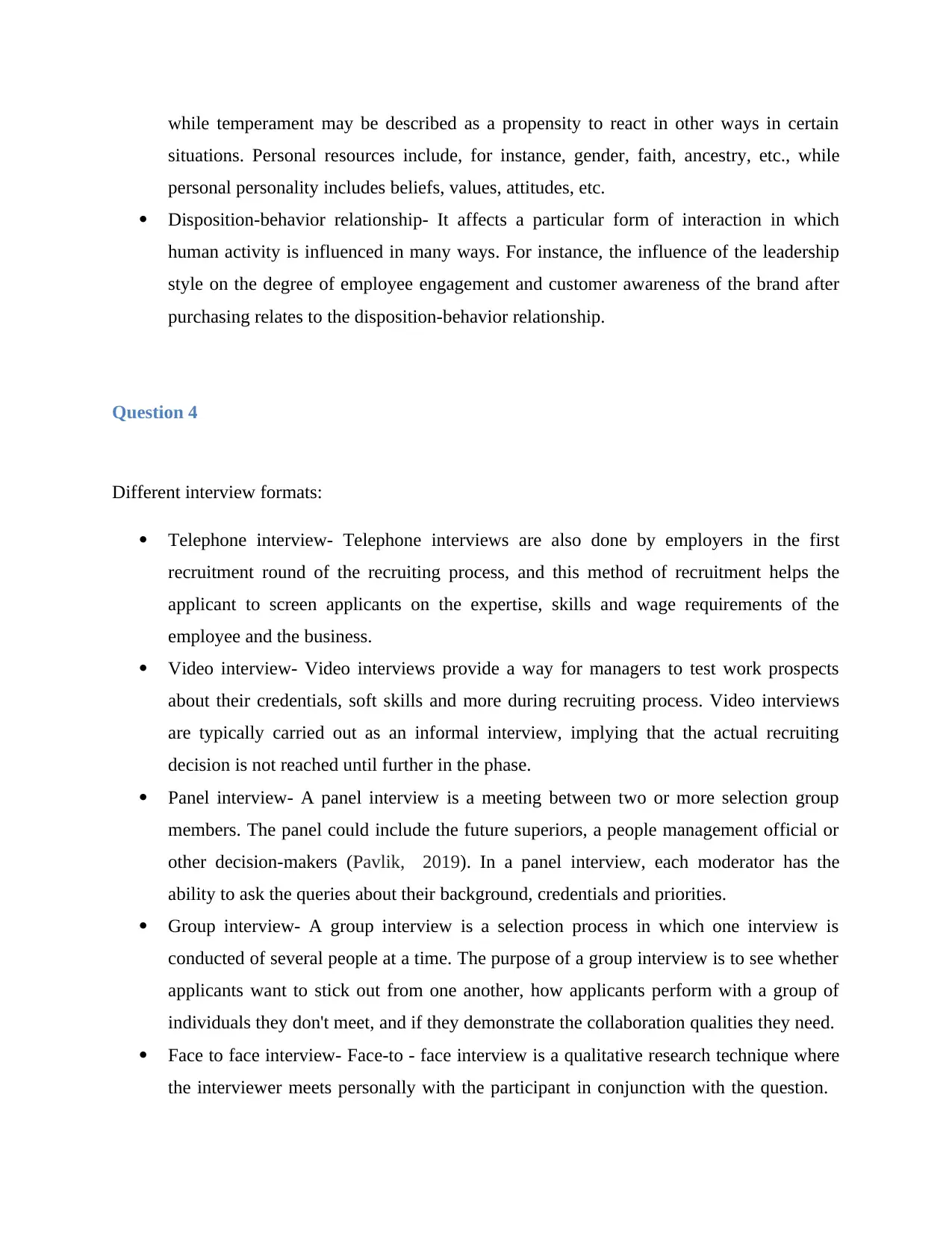
while temperament may be described as a propensity to react in other ways in certain
situations. Personal resources include, for instance, gender, faith, ancestry, etc., while
personal personality includes beliefs, values, attitudes, etc.
Disposition-behavior relationship- It affects a particular form of interaction in which
human activity is influenced in many ways. For instance, the influence of the leadership
style on the degree of employee engagement and customer awareness of the brand after
purchasing relates to the disposition-behavior relationship.
Question 4
Different interview formats:
Telephone interview- Telephone interviews are also done by employers in the first
recruitment round of the recruiting process, and this method of recruitment helps the
applicant to screen applicants on the expertise, skills and wage requirements of the
employee and the business.
Video interview- Video interviews provide a way for managers to test work prospects
about their credentials, soft skills and more during recruiting process. Video interviews
are typically carried out as an informal interview, implying that the actual recruiting
decision is not reached until further in the phase.
Panel interview- A panel interview is a meeting between two or more selection group
members. The panel could include the future superiors, a people management official or
other decision-makers (Pavlik, 2019). In a panel interview, each moderator has the
ability to ask the queries about their background, credentials and priorities.
Group interview- A group interview is a selection process in which one interview is
conducted of several people at a time. The purpose of a group interview is to see whether
applicants want to stick out from one another, how applicants perform with a group of
individuals they don't meet, and if they demonstrate the collaboration qualities they need.
Face to face interview- Face-to - face interview is a qualitative research technique where
the interviewer meets personally with the participant in conjunction with the question.
situations. Personal resources include, for instance, gender, faith, ancestry, etc., while
personal personality includes beliefs, values, attitudes, etc.
Disposition-behavior relationship- It affects a particular form of interaction in which
human activity is influenced in many ways. For instance, the influence of the leadership
style on the degree of employee engagement and customer awareness of the brand after
purchasing relates to the disposition-behavior relationship.
Question 4
Different interview formats:
Telephone interview- Telephone interviews are also done by employers in the first
recruitment round of the recruiting process, and this method of recruitment helps the
applicant to screen applicants on the expertise, skills and wage requirements of the
employee and the business.
Video interview- Video interviews provide a way for managers to test work prospects
about their credentials, soft skills and more during recruiting process. Video interviews
are typically carried out as an informal interview, implying that the actual recruiting
decision is not reached until further in the phase.
Panel interview- A panel interview is a meeting between two or more selection group
members. The panel could include the future superiors, a people management official or
other decision-makers (Pavlik, 2019). In a panel interview, each moderator has the
ability to ask the queries about their background, credentials and priorities.
Group interview- A group interview is a selection process in which one interview is
conducted of several people at a time. The purpose of a group interview is to see whether
applicants want to stick out from one another, how applicants perform with a group of
individuals they don't meet, and if they demonstrate the collaboration qualities they need.
Face to face interview- Face-to - face interview is a qualitative research technique where
the interviewer meets personally with the participant in conjunction with the question.
⊘ This is a preview!⊘
Do you want full access?
Subscribe today to unlock all pages.

Trusted by 1+ million students worldwide
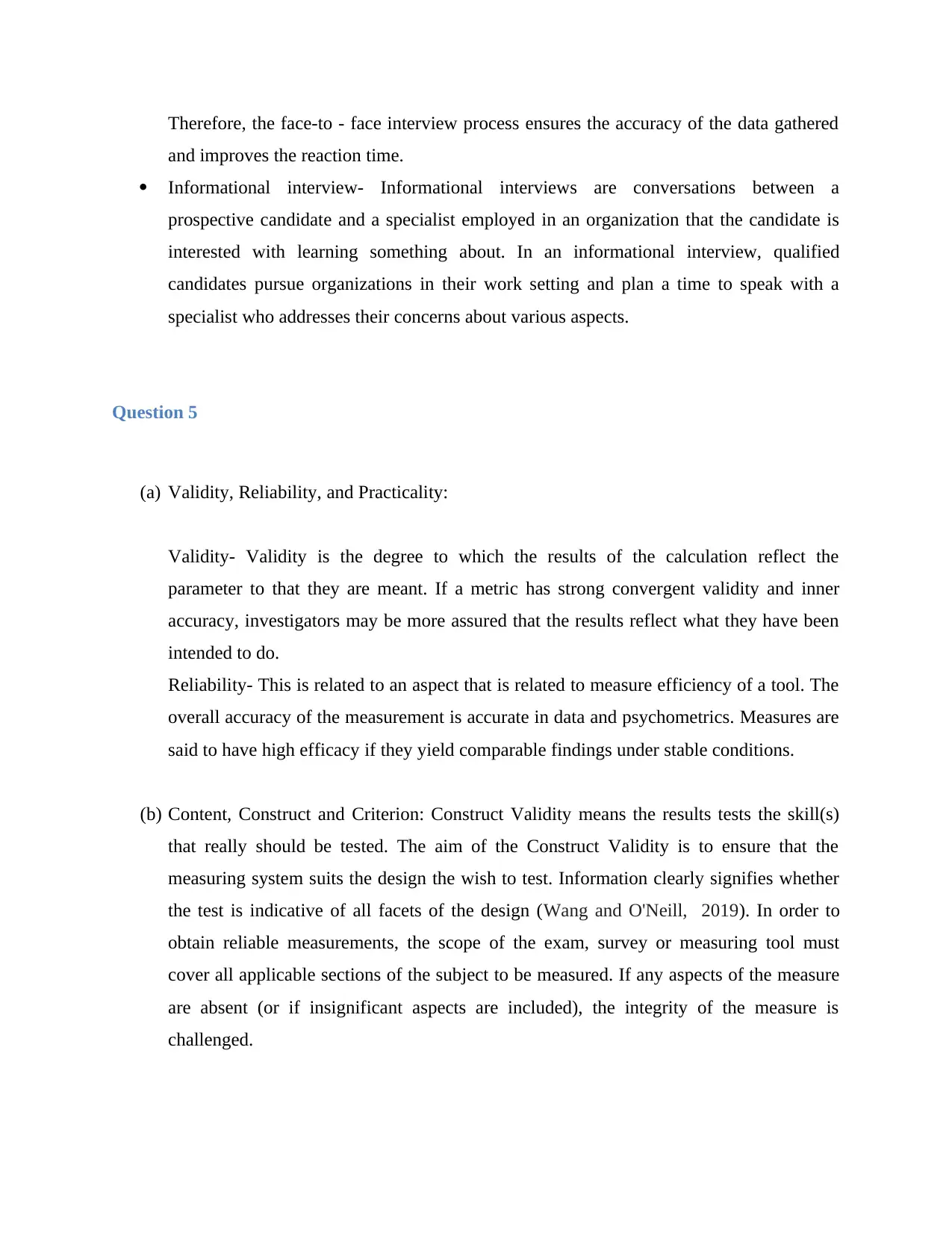
Therefore, the face-to - face interview process ensures the accuracy of the data gathered
and improves the reaction time.
Informational interview- Informational interviews are conversations between a
prospective candidate and a specialist employed in an organization that the candidate is
interested with learning something about. In an informational interview, qualified
candidates pursue organizations in their work setting and plan a time to speak with a
specialist who addresses their concerns about various aspects.
Question 5
(a) Validity, Reliability, and Practicality:
Validity- Validity is the degree to which the results of the calculation reflect the
parameter to that they are meant. If a metric has strong convergent validity and inner
accuracy, investigators may be more assured that the results reflect what they have been
intended to do.
Reliability- This is related to an aspect that is related to measure efficiency of a tool. The
overall accuracy of the measurement is accurate in data and psychometrics. Measures are
said to have high efficacy if they yield comparable findings under stable conditions.
(b) Content, Construct and Criterion: Construct Validity means the results tests the skill(s)
that really should be tested. The aim of the Construct Validity is to ensure that the
measuring system suits the design the wish to test. Information clearly signifies whether
the test is indicative of all facets of the design (Wang and O'Neill, 2019). In order to
obtain reliable measurements, the scope of the exam, survey or measuring tool must
cover all applicable sections of the subject to be measured. If any aspects of the measure
are absent (or if insignificant aspects are included), the integrity of the measure is
challenged.
and improves the reaction time.
Informational interview- Informational interviews are conversations between a
prospective candidate and a specialist employed in an organization that the candidate is
interested with learning something about. In an informational interview, qualified
candidates pursue organizations in their work setting and plan a time to speak with a
specialist who addresses their concerns about various aspects.
Question 5
(a) Validity, Reliability, and Practicality:
Validity- Validity is the degree to which the results of the calculation reflect the
parameter to that they are meant. If a metric has strong convergent validity and inner
accuracy, investigators may be more assured that the results reflect what they have been
intended to do.
Reliability- This is related to an aspect that is related to measure efficiency of a tool. The
overall accuracy of the measurement is accurate in data and psychometrics. Measures are
said to have high efficacy if they yield comparable findings under stable conditions.
(b) Content, Construct and Criterion: Construct Validity means the results tests the skill(s)
that really should be tested. The aim of the Construct Validity is to ensure that the
measuring system suits the design the wish to test. Information clearly signifies whether
the test is indicative of all facets of the design (Wang and O'Neill, 2019). In order to
obtain reliable measurements, the scope of the exam, survey or measuring tool must
cover all applicable sections of the subject to be measured. If any aspects of the measure
are absent (or if insignificant aspects are included), the integrity of the measure is
challenged.
Paraphrase This Document
Need a fresh take? Get an instant paraphrase of this document with our AI Paraphraser
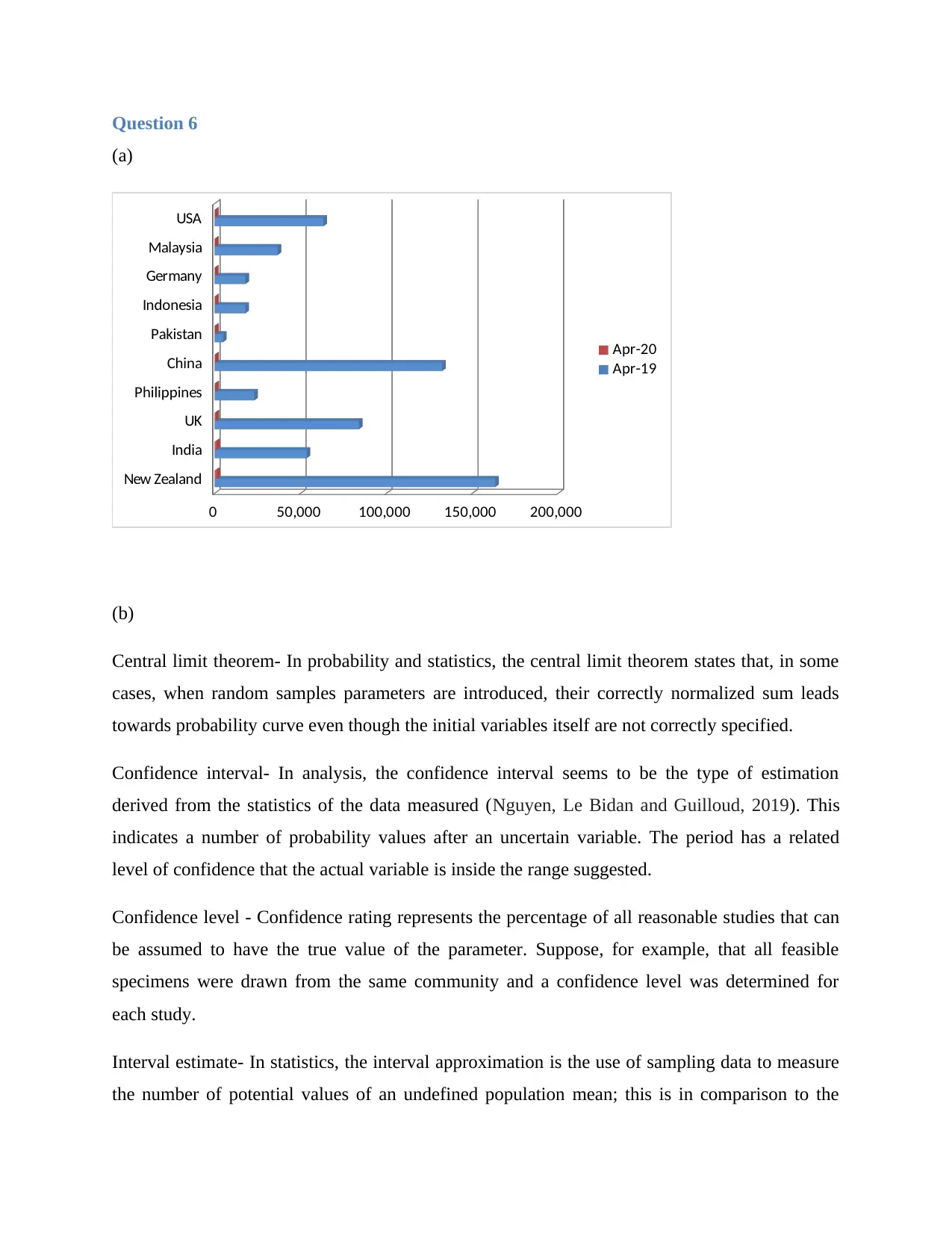
Question 6
(a)
New Zealand
India
UK
Philippines
China
Pakistan
Indonesia
Germany
Malaysia
USA
0 50,000 100,000 150,000 200,000
Apr-20
Apr-19
(b)
Central limit theorem- In probability and statistics, the central limit theorem states that, in some
cases, when random samples parameters are introduced, their correctly normalized sum leads
towards probability curve even though the initial variables itself are not correctly specified.
Confidence interval- In analysis, the confidence interval seems to be the type of estimation
derived from the statistics of the data measured (Nguyen, Le Bidan and Guilloud, 2019). This
indicates a number of probability values after an uncertain variable. The period has a related
level of confidence that the actual variable is inside the range suggested.
Confidence level - Confidence rating represents the percentage of all reasonable studies that can
be assumed to have the true value of the parameter. Suppose, for example, that all feasible
specimens were drawn from the same community and a confidence level was determined for
each study.
Interval estimate- In statistics, the interval approximation is the use of sampling data to measure
the number of potential values of an undefined population mean; this is in comparison to the
(a)
New Zealand
India
UK
Philippines
China
Pakistan
Indonesia
Germany
Malaysia
USA
0 50,000 100,000 150,000 200,000
Apr-20
Apr-19
(b)
Central limit theorem- In probability and statistics, the central limit theorem states that, in some
cases, when random samples parameters are introduced, their correctly normalized sum leads
towards probability curve even though the initial variables itself are not correctly specified.
Confidence interval- In analysis, the confidence interval seems to be the type of estimation
derived from the statistics of the data measured (Nguyen, Le Bidan and Guilloud, 2019). This
indicates a number of probability values after an uncertain variable. The period has a related
level of confidence that the actual variable is inside the range suggested.
Confidence level - Confidence rating represents the percentage of all reasonable studies that can
be assumed to have the true value of the parameter. Suppose, for example, that all feasible
specimens were drawn from the same community and a confidence level was determined for
each study.
Interval estimate- In statistics, the interval approximation is the use of sampling data to measure
the number of potential values of an undefined population mean; this is in comparison to the
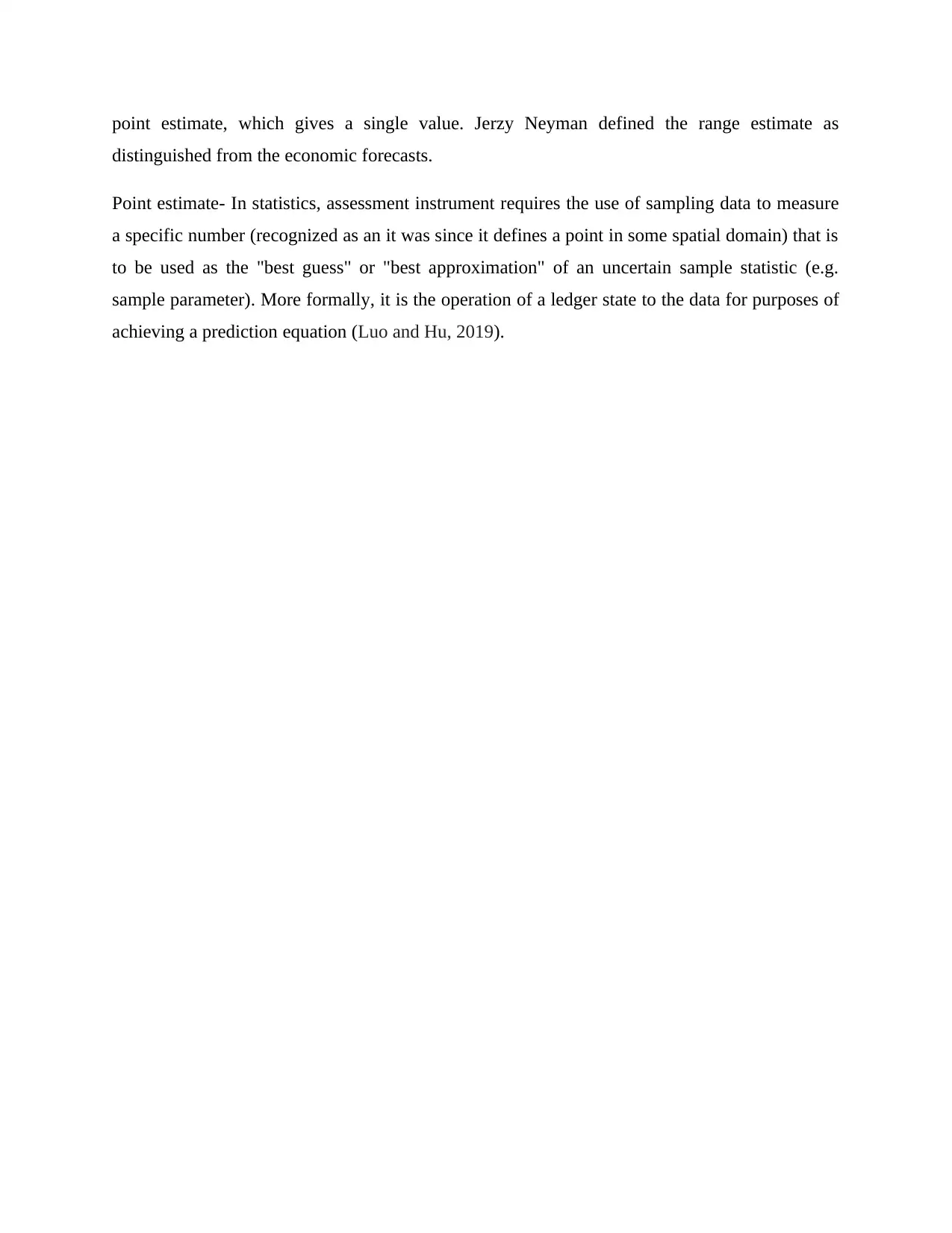
point estimate, which gives a single value. Jerzy Neyman defined the range estimate as
distinguished from the economic forecasts.
Point estimate- In statistics, assessment instrument requires the use of sampling data to measure
a specific number (recognized as an it was since it defines a point in some spatial domain) that is
to be used as the "best guess" or "best approximation" of an uncertain sample statistic (e.g.
sample parameter). More formally, it is the operation of a ledger state to the data for purposes of
achieving a prediction equation (Luo and Hu, 2019).
distinguished from the economic forecasts.
Point estimate- In statistics, assessment instrument requires the use of sampling data to measure
a specific number (recognized as an it was since it defines a point in some spatial domain) that is
to be used as the "best guess" or "best approximation" of an uncertain sample statistic (e.g.
sample parameter). More formally, it is the operation of a ledger state to the data for purposes of
achieving a prediction equation (Luo and Hu, 2019).
⊘ This is a preview!⊘
Do you want full access?
Subscribe today to unlock all pages.

Trusted by 1+ million students worldwide
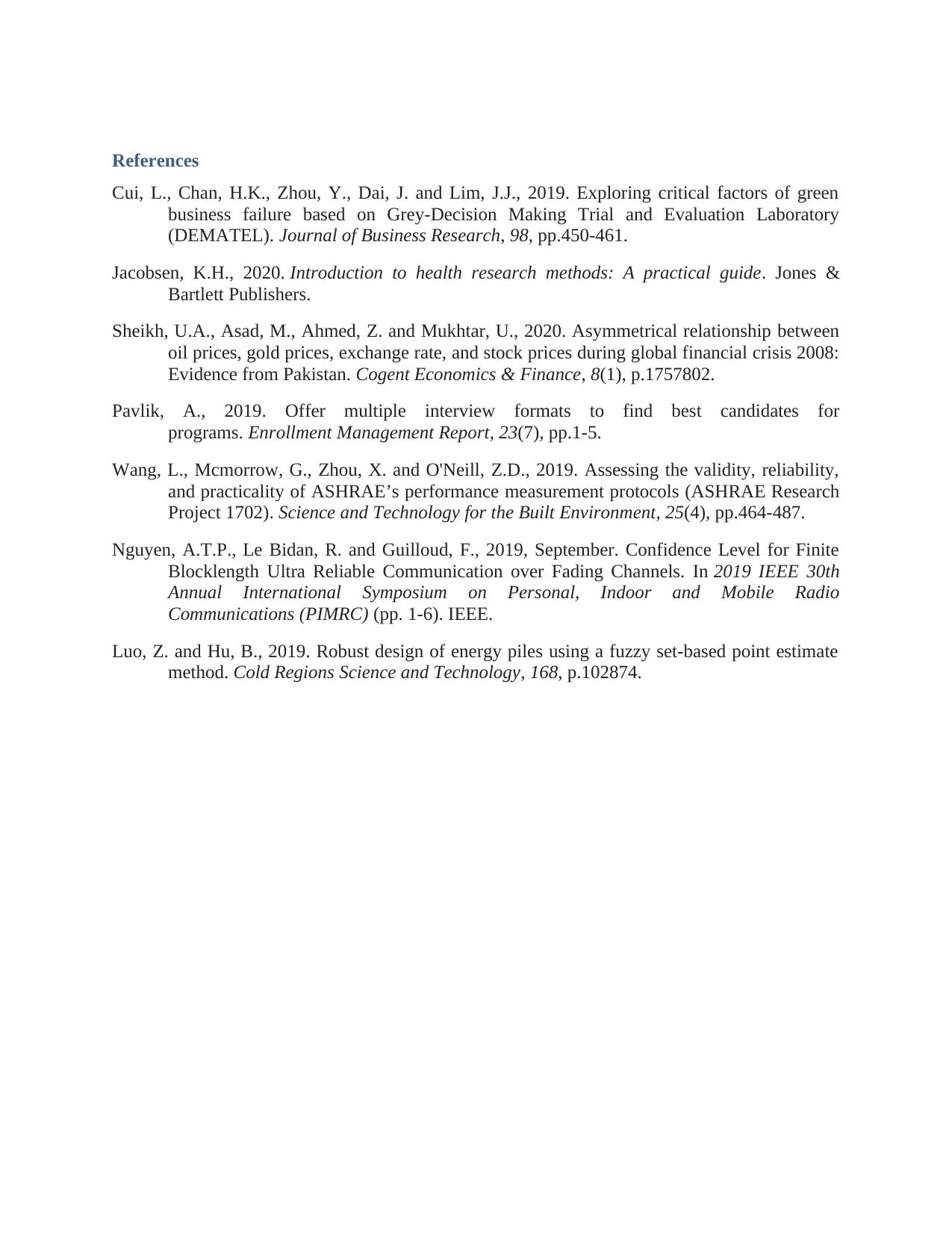
References
Cui, L., Chan, H.K., Zhou, Y., Dai, J. and Lim, J.J., 2019. Exploring critical factors of green
business failure based on Grey-Decision Making Trial and Evaluation Laboratory
(DEMATEL). Journal of Business Research, 98, pp.450-461.
Jacobsen, K.H., 2020. Introduction to health research methods: A practical guide. Jones &
Bartlett Publishers.
Sheikh, U.A., Asad, M., Ahmed, Z. and Mukhtar, U., 2020. Asymmetrical relationship between
oil prices, gold prices, exchange rate, and stock prices during global financial crisis 2008:
Evidence from Pakistan. Cogent Economics & Finance, 8(1), p.1757802.
Pavlik, A., 2019. Offer multiple interview formats to find best candidates for
programs. Enrollment Management Report, 23(7), pp.1-5.
Wang, L., Mcmorrow, G., Zhou, X. and O'Neill, Z.D., 2019. Assessing the validity, reliability,
and practicality of ASHRAE’s performance measurement protocols (ASHRAE Research
Project 1702). Science and Technology for the Built Environment, 25(4), pp.464-487.
Nguyen, A.T.P., Le Bidan, R. and Guilloud, F., 2019, September. Confidence Level for Finite
Blocklength Ultra Reliable Communication over Fading Channels. In 2019 IEEE 30th
Annual International Symposium on Personal, Indoor and Mobile Radio
Communications (PIMRC) (pp. 1-6). IEEE.
Luo, Z. and Hu, B., 2019. Robust design of energy piles using a fuzzy set-based point estimate
method. Cold Regions Science and Technology, 168, p.102874.
Cui, L., Chan, H.K., Zhou, Y., Dai, J. and Lim, J.J., 2019. Exploring critical factors of green
business failure based on Grey-Decision Making Trial and Evaluation Laboratory
(DEMATEL). Journal of Business Research, 98, pp.450-461.
Jacobsen, K.H., 2020. Introduction to health research methods: A practical guide. Jones &
Bartlett Publishers.
Sheikh, U.A., Asad, M., Ahmed, Z. and Mukhtar, U., 2020. Asymmetrical relationship between
oil prices, gold prices, exchange rate, and stock prices during global financial crisis 2008:
Evidence from Pakistan. Cogent Economics & Finance, 8(1), p.1757802.
Pavlik, A., 2019. Offer multiple interview formats to find best candidates for
programs. Enrollment Management Report, 23(7), pp.1-5.
Wang, L., Mcmorrow, G., Zhou, X. and O'Neill, Z.D., 2019. Assessing the validity, reliability,
and practicality of ASHRAE’s performance measurement protocols (ASHRAE Research
Project 1702). Science and Technology for the Built Environment, 25(4), pp.464-487.
Nguyen, A.T.P., Le Bidan, R. and Guilloud, F., 2019, September. Confidence Level for Finite
Blocklength Ultra Reliable Communication over Fading Channels. In 2019 IEEE 30th
Annual International Symposium on Personal, Indoor and Mobile Radio
Communications (PIMRC) (pp. 1-6). IEEE.
Luo, Z. and Hu, B., 2019. Robust design of energy piles using a fuzzy set-based point estimate
method. Cold Regions Science and Technology, 168, p.102874.
1 out of 10
Related Documents
Your All-in-One AI-Powered Toolkit for Academic Success.
+13062052269
info@desklib.com
Available 24*7 on WhatsApp / Email
![[object Object]](/_next/static/media/star-bottom.7253800d.svg)
Unlock your academic potential
Copyright © 2020–2025 A2Z Services. All Rights Reserved. Developed and managed by ZUCOL.





